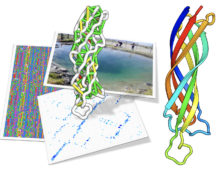To better understand the molecular mechanisms underlying environmental response of K. laxiflora, the team will study temporal and tissue specific changes in global gene expression in response to different treatments, including temperature, light intensity, water-deficit stress and nitrogen sources. They also propose to examine the role of circadian and metabolite control over the CAM leaf transcriptome. The…
Fungal Interaction Networks in Soil Crusts
Extremophilic fungi possess adaptations that enable successful colonization of environments characterized by extremes of temperature, water activity, salinity, radiation, and/or pH. As part of a broad emphasis on understanding these adaptations, the long-term objective of the team’s research is to determine how fungi interact with photoautotrophs (algae and cyanobacteria). Their work focuses on fungal interactions…
Microbes’ Role in Plant Fitness Under Induced Drought
The team will investigate the role of root-associated Actinobacteria in promoting host fitness under drought stress in two plants important to the DOE mission of sustainable biofuels. Preliminary data suggest that Actinobacteria are reproducibly more abundant in the roots of drought-treated sorghum and rice than in those of well-watered controls. They hypothesize: 1) that the enriched…
Geo-Metabolomics in a Saltmarsh
Current understanding of how bacteria metabolize plant-derived compounds is surprisingly limited given the importance of these processes to the global carbon cycle. The researchers hypothesize that nominally “recalcitrant” t-DOM in salt marshes is made more reactive by pulses of labile DOM derived from coastal wetland marshes and phytoplankton. Outcomes of their studies have the potential to…
Metagenomics Leads to New CRISPR-Cas Systems
First CRISPR-Cas9 system in archaea discovered The Science Through metagenomic data generated by the DOE Joint Genome Institute, researchers analyzed 155 million protein coding genes from uncultivated microbial communities, leading to the discovery of the first CRISPR-Cas9 protein in the archaeal domain, and of two previously unknown simple bacterial CRISPR-Cas systems. The Impact Microbes play…
Taking the First Steps to Colocating Biosciences at the Berkeley Lab
On January 31 at Berkeley Lab, a groundbreaking ceremony was held for the Integrative Genomics Building (IGB) that will be the home of DOE Joint Genome Institute (JGI) and DOE Systems Knowledgebase (KBase) in 2019. Flanked by dignitaries representing the Berkeley Lab, the Department of Energy Office of Science, and the University of California, incoming…
Seeking Structure With Metagenome Sequences
Metagenomics database helps fill in 10 percent of previously unknown protein structures For proteins, appearance matters. These important molecules largely form a cell’s structures and carry out its functions: proteins control growth and influence mobility, serve as catalysts, and transport or store other molecules. Comprised of long amino acid chains, the one-dimensional amino acid sequence…
Tracking Antarctic Adaptations in Diatoms
Comparative genome analysis provides clues on how climate change might impact evolutionary adaptation limits Diatoms are a common type of photosynthetic microorganism, found in many environments from marine to soil; in the oceans, they are responsible for more than a third of the global ocean carbon captured during photosynthesis. This leads to a significant amount…
Industrial Biotechnology Leader to Assume the Helm of the DOE Joint Genome Institute
After a 9-month national search, Nigel Mouncey, currently Research and Development Director for Bioengineering and Bioprocessing at Dow AgroSciences LLC, has been selected as the Director of the U.S. Department of Energy Joint Genome Institute (DOE JGI), a DOE Office of Science User Facility. “Nigel brings the perfect set of scientific and management skills as…
DOE JGI Research Featured in NOVA PBS story
“Using the single-celled sequencing techniques that she had perfected at the Joint Genome Institute, Woyke and her colleagues ended up with exactly 201 genomes from these candidate phyla, representing 29 branches on the tree of life that scientists knew nothing about. ‘For many phyla, this was the first genomic data anyone had seen,’ she says.”…





